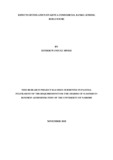| dc.description.abstract | The motivation behind this study was to determine if there exists a connection between inflation yearly lending rate and Kenya Commercial Banks' loaning conduct, regarding loaning volumes financing costs and credit values. This examination was guided by the accompanying questions?(i) what is the connection between yearly rate of inflation and base loaning rates in kenya from the year 2012 to 2016?(ii)What is the connection between both inflation and base lending rate and lending volumes between the year 2012 to 2016? The investigation has adopted a clear research plan with the objective population containing top five Kenyan banks. Auxiliary information on inflation rates, new volumes of loaning to borrowers, and bank base lending rates were gathered. A sample size of five banks was chosen through multi arranged examining strategy. Secondary data was acquired from CBK and World Bank records while information on inflation was obtained from the Kenya National Bureau of Statistics, through their web site. In light of the findings, different suggestions were made. First, the bank will use the information to help formulate policies on minimum base lending rate to be charged on loans. In order to maintain this, the banks would need to diversify to other sources of income streams. For example, aggressively undertaking non interest related activities e.g. collection of commission and fees to cushion it during high inflation period when uptake of loans dwindle .Since the banks have no control of macroeconomic factors affecting inflation in the country The primary conclusion was the there exists a positive connection between inflation rate and the base loaning rate charged by the bank, as inflation levels rises, so will the banks base loaning rate both from the key informant figures and the investigation of the analysis, demonstrating that expansion significantly affects Banks base loaning rate. The second finding was that inflation has moderate impact on new loaning volumes; in any case, an expansion in base loaning rate contributed most towards the decrease in the loaning volumes. The third discovering uncovered that an increase in inflation prompted high rate of advance defaulting by customers in the bank. | en_US |



